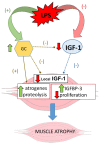IGF-1 and IGFBP-3 in Inflammatory Cachexia
- PMID: 34502376
- PMCID: PMC8430490
- DOI: 10.3390/ijms22179469
IGF-1 and IGFBP-3 in Inflammatory Cachexia
Abstract
Inflammation induces a wide response of the neuroendocrine system, which leads to modifications in all the endocrine axes. The hypothalamic-growth hormone (GH)-insulin-like growth factor-1 (IGF-1) axis is deeply affected by inflammation, its response being characterized by GH resistance and a decrease in circulating levels of IGF-1. The endocrine and metabolic responses to inflammation allow the organism to survive. However, in chronic inflammatory conditions, the inhibition of the hypothalamic-GH-IGF-1 axis contributes to the catabolic process, with skeletal muscle atrophy and cachexia. Here, we review the changes in pituitary GH secretion, IGF-1, and IGF-1 binding protein-3 (IGFBP-3), as well as the mechanism that mediated those responses. The contribution of GH and IGF-1 to muscle wasting during inflammation has also been analyzed.
Keywords: GH; IGF-1; IGFBP-3; cachexia; cytokines; glucocorticoids; inflammation; muscle wasting; nitric oxide; sepsis.
Conflict of interest statement
The authors declare no conflict of interest. The funders had no role in the design of the study; in the collection, analyses, or interpretation of data; in the writing of the manuscript, or in the decision to publish the results.
Figures


Similar articles
-
Experimental arthritis inhibits the insulin-like growth factor-I axis and induces muscle wasting through cyclooxygenase-2 activation.Am J Physiol Endocrinol Metab. 2007 Jun;292(6):E1656-65. doi: 10.1152/ajpendo.00502.2006. Epub 2007 Feb 6. Am J Physiol Endocrinol Metab. 2007. PMID: 17284570
-
Age-dependent changes in body composition in postmenopausal Japanese women: relationship to growth hormone secretion as well as serum levels of insulin-like growth factor (IGF)-I and IGF-binding protein-3.Eur J Endocrinol. 1998 Jun;138(6):633-9. doi: 10.1530/eje.0.1380633. Eur J Endocrinol. 1998. PMID: 9678529 Clinical Trial.
-
Growth hormone, insulin growth factor-1, and igf binding protein-3 axis relationship with bone mineral density among healthy men.Arch Androl. 2003 May-Jun;49(3):191-9. doi: 10.1080/01485010390196724. Arch Androl. 2003. PMID: 12746097
-
[Growth hormone secretion in heart failure].Minerva Endocrinol. 2003 Mar;28(1):1-11. Minerva Endocrinol. 2003. PMID: 12621359 Review. Italian.
-
A hypothesis for a possible synergy between ghrelin and exercise in patients with cachexia: Biochemical and physiological bases.Med Hypotheses. 2015 Dec;85(6):927-33. doi: 10.1016/j.mehy.2015.09.008. Epub 2015 Sep 12. Med Hypotheses. 2015. PMID: 26404870 Review.
Cited by
-
The inflammatory response, a mixed blessing for muscle homeostasis and plasticity.Front Physiol. 2022 Nov 23;13:1032450. doi: 10.3389/fphys.2022.1032450. eCollection 2022. Front Physiol. 2022. PMID: 36505042 Free PMC article. Review.
-
Characterization model of the post COVID-19 condition based on immunological, biochemical, and cytokine markers.iScience. 2024 Aug 30;27(9):110839. doi: 10.1016/j.isci.2024.110839. eCollection 2024 Sep 20. iScience. 2024. PMID: 39318534 Free PMC article.
-
LncRNA Snhg12/IGFBP3 axis is involved in liver fibrosis by promoting the proliferation and activation of mouse hepatic stellate cells.J Cell Commun Signal. 2024 May 28;18(2):e12033. doi: 10.1002/ccs3.12033. eCollection 2024 Jun. J Cell Commun Signal. 2024. PMID: 38946724 Free PMC article.
-
Iturin A Rescued STb-R-Induced Pork Skeletal Muscle Growth Restriction through the Hypothalamic-Pituitary-mTORC1 Growth Axis.Animals (Basel). 2022 Jun 17;12(12):1568. doi: 10.3390/ani12121568. Animals (Basel). 2022. PMID: 35739903 Free PMC article.
-
Conditioned Media from Head and Neck Cancer Cell Lines and Serum Samples from Head and Neck Cancer Patients Drive Catabolic Pathways in Cultured Muscle Cells.Cancers (Basel). 2023 Mar 19;15(6):1843. doi: 10.3390/cancers15061843. Cancers (Basel). 2023. PMID: 36980729 Free PMC article.
References
Publication types
MeSH terms
Substances
Grants and funding
LinkOut - more resources
Full Text Sources
Miscellaneous

